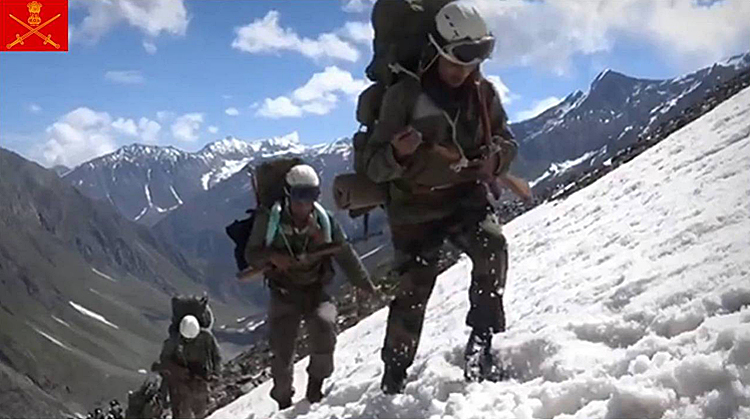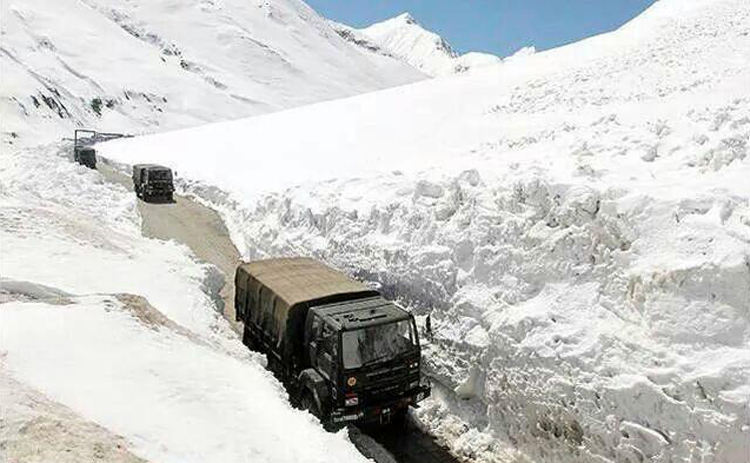INDIAN ARMED FORCES CHIEFS ON
OUR RELENTLESS AND FOCUSED PUBLISHING EFFORTS

SP Guide Publications puts forth a well compiled articulation of issues, pursuits and accomplishments of the Indian Army, over the years

I am confident that SP Guide Publications would continue to inform, inspire and influence.

My compliments to SP Guide Publications for informative and credible reportage on contemporary aerospace issues over the past six decades.
- Prime Minister witnesses 'Bharat Shakti' – a Tri-Services Firing and Manoeuvre Exercise in Pokhran, Rajasthan
- Interim Defence Budget 2024-25 — An Analysis
- Union Defence budget 2024
- Prime Minister Modi Commemorates Indian Navy Day in a Grand Ceremony
- Prime Minister Modi Flies in the LCA Tejas
- New Chapter in India-Italy Defence Ties
- Airpower beyond Boundaries
Army's LAC Corps
Considering frequent face-offs with Chinese troops at certain disputed points along the LAC, the Army is converting its Bareilly- based Headquarters Uttar Bharat (HQ UB) area into a full-fledged operational corps, referring the formation to as Combatised UB Area
 |
The Author is Former Director General of Information Systems and A Special Forces Veteran, Indian Army |


According to media reports, the Army is converting its Bareilly- based Headquarters Uttar Bharat (HQ UB) area into a full-fledged operational corps — a move that will shift its focus towards operations along the Line of Actual Control (LAC) from its current responsibility of peacetime duties. Currently, this HQ is a static formation responsible for peacetime locations and training establishments of Uttarakhand and western Uttar Pradesh, in addition to the LAC running along the Central Sector in Himachal Pradesh and Uttarakhand. This is a good move considering the continuing standoff with China since April-May 2020 along the entire LAC and aggressive moves in the Central Sector, including development of border infrastructure and new posts.
Post the 2020 Chinese aggression in eastern Ladakh, the Indian Army mobilised around 68,000 troops and carried out a precautionary deployment all along the 3,488 km LAC. In 2021, a reorganisation was carried out with reorientation of the Mathura-based 1 (Strike) Corps to share the task with the Panagarh-based 17 Mountain Corps to guard the LAC with China. Earlier, 1 Corps operational commitment was only in the western border with Pakistan. Since then, the Army has affected a precautionary deployment all along the LAC that included the Central Sector, especially in Uttarakhand, which comprises of four valleys, starting with Harshil, Mana, Niti and Barahoti.
The newly reconstituted Corps will have all the troops and equipment from other arms and services such as artillery, engineers, and aviation under its direct command
Earlier, the UB area had only one brigade and a few scout battalions under it to patrol key border areas. But considering frequent face-offs with Chinese troops at certain disputed points along the LAC and an enhanced focus on dominating the border, the formation was gradually upgraded and its combat capability increased by putting three independent brigades and an infantry division based in Uttarakhand under it. The formation is currently referred to as Combatised UB Area.
While a combatised Area HQ has fighting elements, a traditional Corps has additional artillery brigades, engineering brigades and other logistics components. The newly reconstituted Corps will have all the troops and equipment from other arms and services such as artillery, engineers and aviation, among others, under its direct command to successfully conduct operations in the Middle Sector.

As per officials, the increased troop densities in the area and additional emerging operational requirements have necessitated a change of focus towards operational tasks. Changing the static formation to an operational corps, officials added, would change the focus of the organisation, which will now be on carrying out various operational tasks even as Sub Areas and training establishments continue to focus on their traditional peacetime roles. The report further says that raising this corps will help bolster development of border infrastructure and combat logistics facilities and the Corps HQ will be the centralised response agency for all security threats in the region.
Raising this corps will help bolster development of border infrastructure and combat logistics facilities, with the Corps HQ as the centralised response agency for all security threats in the region
While the Army is doing its bit, as a nation we are still nowhere close to present an integrated front to our adversaries like the Border Divisions of China under command the Peoples' Liberation Army (PLA), now further reinforced by a new border law and dual-used military villages replete with EW and air defence elements. To top this, we have the policy makers with no sense of urgency, amounting to sheer unprofessionalism even in critical situations.
As pointed out by a veteran-scholar, during the Kargil Conflict, it took 13 days for approving the employment of the Indian Air Force (IAF), that too with a caveat that the Line of Control (LoC) will not be crossed in any event. Why then have an Air Force? Field and Medium artillery can do the job without crossing the LoC. Did they understand the military implications of the decision on our own operations? Did they understand the impossibility of major India-Pakistan war then, owing to the situation in Pakistan and its fear of Pakistan getting further split if it goes in for another major war? Why have Special Forces if they are ordered to not cross the LoC and are used to mount attacks on enemy defences like the infantry?

The decision was arrived at after consulting everyone including CAPF heads. The bureaucracy unfortunately doesn't understand that the enemy, especially in a digitised environment, will not wait for our policy makers to make decisions. Has the situation changed today after 25 years? As a nation, are we geared to meet the challenges of 'an integrated joint operations in a digitised environment? Why have only those recommendations of the Kargil Committee Report been implemented which suit the bureaucracy?
The veteran-scholar further writes that at the time of the 20-km deep PLA intrusion in Depsang in 2013, which threatened Daulat Beg Oldie (DBO), the ad-hoc body of China Study Group (CSG) consisting of the NSA, and bureaucrats from other ministries including heads of Central Security Agencies took control of the situation. 30-odd Chinese soldiers are too insignificant a number to derail the normal processes of Government functioning. The need for restructuring the Integrated Headquarters of the MoD with professional bureaucracy consisting of experts from strategic, military and diplomatic community rather than the present generalist has not been realised even today.
The Indo-Tibetan Border Police (ITBP) mans the LAC but does not come under the Indian Army's operational control, leading to ambiguity in command and control in critical situations
The Indo-Tibetan Border Police (ITBP) under the Ministry of Home Affairs (MHA), a Central Armed Police Force (CAPF), mans the LAC. The ITBP does not come under the Indian Army or its operational control. When an incident of this nature occurs, whom does the ITBP report to? What is the Army supposed to do? Who will issue the orders, the MHA or the MoD? Who will coordinate the situation on the ground? Dual control of critical forces deployed right at the border is a great folly. The ambiguity and the consequences of such vague command and control set up are clearly visible. These are areas where turf wars should be unacceptable.
Excerpts of the autobiography 'Four Stars of Destiny' by former Army Chief General M.M. Naravane have been in the media for all to read. It brings out that even in a critical situation like PLA tanks seen advancing on our posts, no emergency meeting of the Cabinet Committee of Security was convened. Is this our sense of national security?





